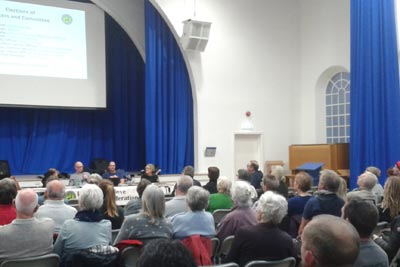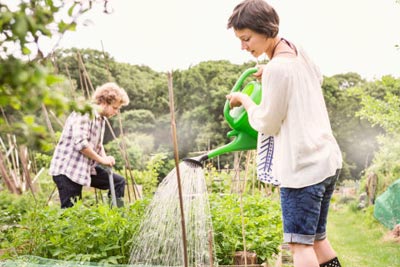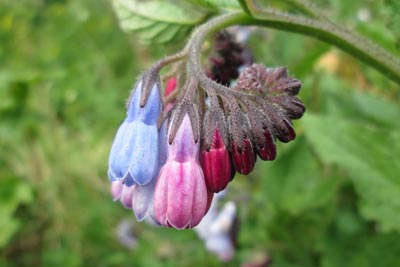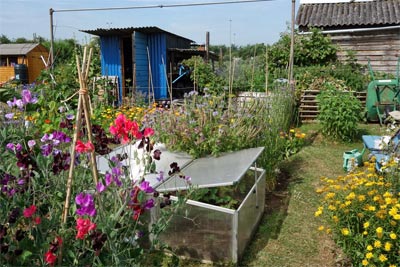 |
|
Dear Plot Holders,
Thanks to all those who attended the AGM last month. It was great to see so many of you there and to hear from Dr Beth Nicholls of Team Pollinate from Sussex University. Another big welcome to our latest Allotment Association; Keston. We have now seen the formation of 2 new associations in the last couple of years! As promised there is a link below to the 'water savings' talk that Mark put together. Most of it's content is obvious but there are also some clever tips in there borrowed from 'permaculture' ideas. Please share this document. Cutting our water bill would be of huge benefit to us all and could help put off any major rent rises.  The newsletters will hopefully take a new direction over the coming months, we aim to produce practical growing tips and also thought provoking articles. We welcome submissions on anything allotment related. If you feel like writing something to be included then please do!
To start, below, is an article from our new chairman Mark Carroll ; 'The changing nature of allotments' where he describes what he sees as a 'Culture Clash' on some of the cities sites. But first of all some great news from Whitehawk Hill. Scarce and Threatened Beetle Breeding on Brighton Allotment Site
This is the stunning Chrysolina sanguinolenta, a beetle which has become very rare in Sussex but it now seems that it is breeding on one of our allotment sites! It was first spotted at Craven Vale Allotments in 2016, and recently many more of them have been seen there, it looks like there is a colony breeding there.  According to the Natural History Museum this species is scarce and threatened. As allotmenteers we know how much bio-diversity is to be found on allotments and how important they are for the wider environment. Of course a wide variety of pollinators is also a big benefit for us food growers. Most plot holders are now managing their plots with this in mind, and the BHAF encourage people to stop using pesticides, insecticides and herbicides and to grow as organically as they can. If we do, then perhaps we'll see many more rare species popping up on our plots! Thanks to Graeme Lyons, who identified the beetle, and for the pictures. Here is his Blog from 2016 when he first found it. Water Saving Tips using 'Permaculture' ideas.
The allotment service has a deficit of approximately £35,000. Which means, according to their figures, it costs £35,000 more for the Council to run the service than they collect in rents. Given the continuing Government cuts to the Council's finances, the allotment service is under pressure to reduce this deficit. Ideally we should aim for a point where the allotment service is cost neutral. As long as the service is costing more to run than it receives in revenue there will be pressure to increase allotment rents.
A high proportion of current allotment expenditure (circa £30,000) relates to water usage. Reducing unnecessary water usage is therefore beneficial from a budget perspective, as well as having sustainability benefits for the wider environment and community.
 We have put together a little document showing how we can aim to reduce our water bill substantially. From obvious ideas to less well known 'permaculture' ideas like swales and mulching, this little document might help to inspire us to waste less water and use less water. Download it here.
The changing nature of Allotments
This short article explores the changing ethos of allotmenteering, and how a kind of culture clash is causing issues on some of the cities allotment sites which need addressing.
The nature of allotments has changed dramatically over the last 20 years. Allotments used to typically be the reserve of the retired older gentleman and his shed, and there was a certain manner of gardening which was practiced. For example, allotment societies arranged competitions for the ‘best plot’ and the way in which this was judged was down to some very specific guidelines. A few years ago I even saw competition score sheets which gave extra marks for the straightness of the rows of vegetables! There was an air of regimentality which pervaded allotment sites, perhaps many of the allotment holders of the 80’s and 90’s had done national service and even fought in the war, which may explain where that manner of allotmenteering was so prevalent. They represented an allotment culture which was mainly older and male and had pervaded for many years, but was now slowly disappearing. In the 80’s and 90’s allotments went into decline, many sites became derelict, unused plots were everywhere. However, things have changed. The older retired gentlemen are still there, and long may they remain! But a new breed of allotmenteers has arrived on the sites. The average allotmenteer in Brighton and Hove is now a woman in her late 40’s early 50’s. This new breed of plot holder is looking for a very different allotment experience than the previous generation. They are interested in growing organic vegetables, in getting back in touch with nature and they weren’t particularly bothered if their carrots were not in a straight line. Families started to bring their children so that they could understand where their food came from and maybe find some slow worms and build a little pond for frogs. Pesticides and chemical fertilisers were out... nature and bio-diversity was in. Allotments are some of the most bio-diverse spaces in the city and beyond, their value to the wider environment is huge. The benefits that allotments bring to physical and mental health cannot be underestimated either. This influx of people looking for these new benefits of an allotment has filled up the allotments and now there are long waiting lists. Allotments have never been so popular, and this is great news. Allotments are once again a central part of urban life, and now for a much broader part of the community.  There are a large number of new tenants who take an allotment for the benefits it brings to not just their physical, but especially their mental health. Working a plot is well known to reduce stress levels, and some doctors have actively been encouraging people to take a plot for the mental health benefits it brings. It is now well understood that the outdoor activity of working an allotment is a fantastic way to improve mental well being. It’s not just those with actual mental health issues who are searching out the benefits of an allotment. Modern life is hectic and many want to use their leisure time to actively reduce their stress by working a plot and enjoying nature. However this new use of allotments has not been without issues. Some people taking on allotments for the mental health benefits have found that they actually end up bringing more stress into their lives! Unfortunately the regimental mentality of yesteryear seems to be lingering on in certain places. And this mentality is in direct conflict with the new allotment user and there is a clash of cultures. Part of the problem seems to be that Councils up and down the Country are taking a long time to get to grips with the change. It sometimes seems like they prefer the more regimented approach to managing allotments and are loathed to accept the new paradigm. I suppose this is understandable to a degree, as managing allotments is not easy in any case, and the new considerations present complex issues to be taken on board. One of the things that Councils have done in the last few decades to save money has been to hand over the day to day management of sites to volunteer Site Reps. In many ways this is a pragmatic approach, and it can be successful, but it is also not without its problems.  The Site Reps role is a very complex one. They are volunteers and they find themselves stuck in the middle between plot holders (who they are supposed to represent) and the Council (whose direction they are supposed to follow). These dual perspectives are often contradictory. Site Reps are responsible for letting the plots, managing the site, carrying out inspections, deciding who gets threatened with eviction as well as helping plot holders, representing them and settling disputes between them. They become the interface between the Council and the public, and between plotholders. Most carry out this role in a remarkably efficient and friendly way, they consult and try to be flexible. Some however have problems, and it is not all that surprising. Site Reps do not need to be qualified or experienced in managing people; they receive little to no special training, they are in many cases left to ‘make it up as they go along’, and most do successfully. However, dealing with the public is never easy, especially if to a larger degree people under stress, and some with mental health issues, are turning to allotments to find refuge. More and more often, Site Reps are being asked to manage and deal with sometimes vulnerable people who have complex issues. Dealing with such a vast cross section of the public requires skill or a natural aptitude to the task. In most cases Site Reps rightly see their role as helping and supporting the plot holders, and do it splendidly well, but there is also a minority who still resort to a mentality of the past, and try to maintain a tight unyielding control. The Councils allotment service is sometimes prone to this mentality as well and there lies a problem.
Sadly we sometimes hear stories about people being reduced to tears on certain allotment sites. We also receive emails from people exasperated by the tone and manner in which they are communicated with. To me, this feels like a tragedy. Even if just one person who comes to an allotment site to try and find some benefit for their stress or mental health ends up feeling worse is one too many. People become emotionally connected with their allotments. A piece of land for some is a tangible connection with a natural reality, and more people are finding this connection something that they rely on to provide a sense of peace in the chaotic urban landscape. The Allotment service is just that, a service to provide people with allotments of our once common land, for the primary function of growing vegetables, fruit and flowers. But the way people want to manage their allotment is changing, and Councils need to recognise that their service users have changed their requirements and deserve to be listened to.
 We are not saying that we should tear up the rule book and allow people to neglect or not cultivate their allotments! But we do feel that the environment needs to change to one of an inclusive community of people supporting and helping each other and be less of a regime managed by a few at the top. Plot holders should be supported and communicated with in a friendly but realistic way. Plots do of course need to be worked to a satisfactory degree, but people who want to grow organically, have a swing for the kids, use green manures or have a little area for butterflies or solitary bees should not be discriminated against or made to feel uncomfortable. On the vast majority of sites the new ethos is working amazingly well, and supportive, inclusive communities have grown up centred around helpful Site Reps and in some cases friendly Association huts where everyone can drop in for a friendly cup of tea. If Councils are to continue to ask Site Reps to manage the service for them, then they need to make sure that the Site Reps are properly equipped to deal with the public, and especially the more vulnerable members of the public, in a conscientious non discriminatory way that is reviewed and assisted.
The 2014 allotment strategy set about adjusting the ethos for allotment gardening in the city. We must ensure the service is provided in line with the overarching aims of the strategy, particularly in respect of organic gardening, encouraging bio-diversity and understanding the need for a more sensitive approach to the wide diversity of plot holders. We have alerted Council officers to the concerns about site community relationships but we do not feel that they have yet taken them seriously enough. Making Councillors and the wider community more aware of the problem is important, and all our members have a part to play in that.
We are very proud of the Allotment Strategy. It aims for an allotment service which is productive, exciting, diverse and environmentally conscious and which can deliver benefits for the whole community not just plot holders themselves. We hope to garner some renewed focus to fully implement the aims of the Strategy across all sites of the city. Brighton and Hove's allotment service could be a flagship service for the rest of the Country to follow and we will work alongside the Council to support this!
Discover the biosphere at Castle Hill, take in the beauty of the South Downs, picnic at Stanmer Park and finish with tea in Portslade, hosted by Emmaus.You will be helping to establish a new designated pathway for our City, while raising money for your chosen Mayor’s Charity. National Park Rangers will accompany you on the walk. Saturday 28th April 2018. 9.30am Saltdean to Portslade. http://www.brightonandhoveway.org.uk/ The walk is 18 miles from start to finish, however you can do as much or as little as you like. Entry costs £6 for adults and children can join for free. Dogs are also welcome on a short lead. Register here; Brighton and Hove Way Register A year on a wildlife friendly allotment plot!
Allotments can be great places for wildlife especially when planted and maintained in a wildlife-friendly way.  The history of each vegetable
Fascinating guide to the origins of our vegetables.
|